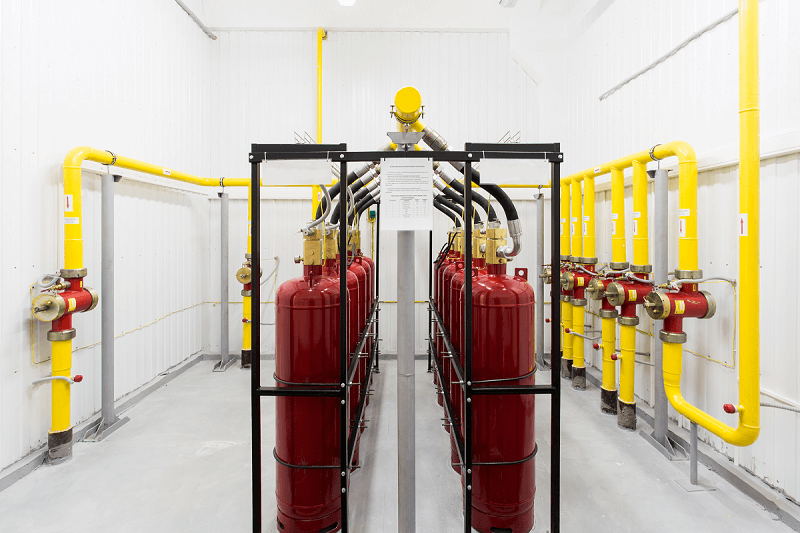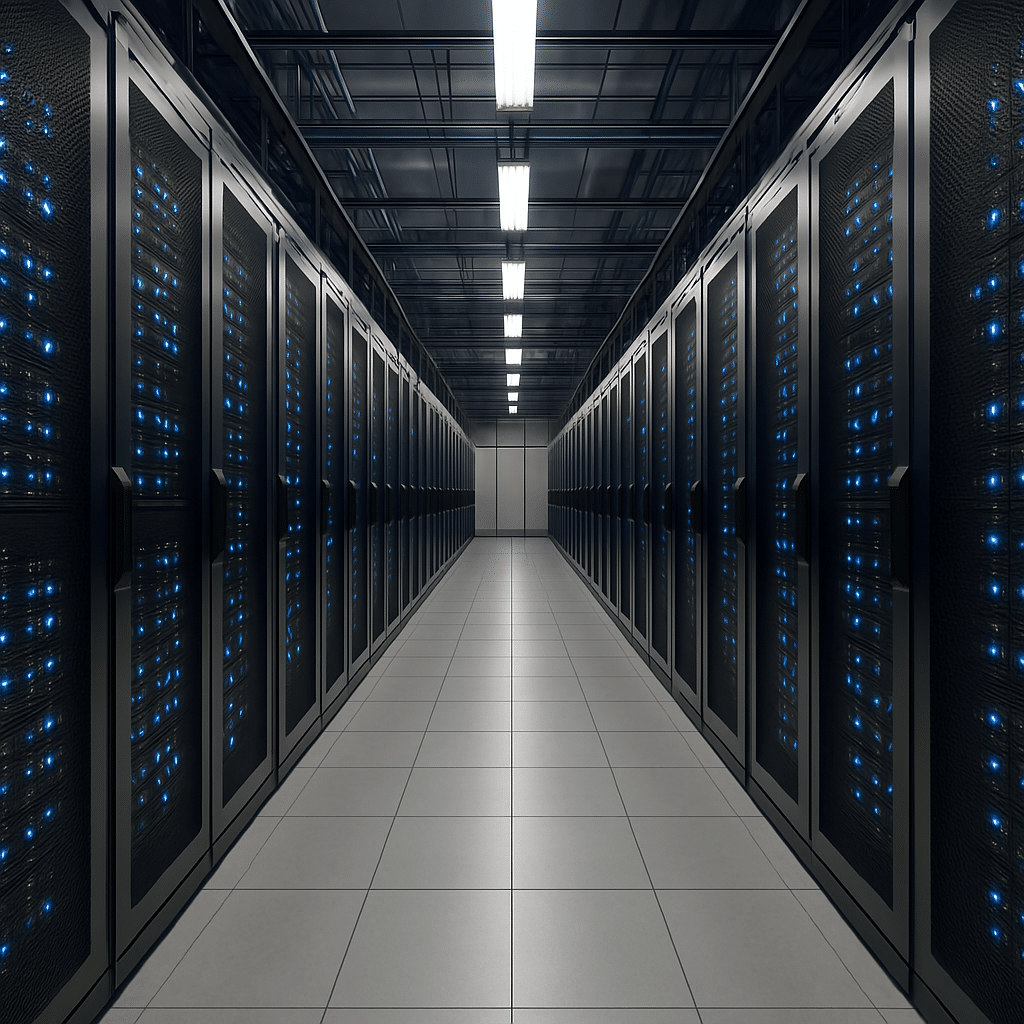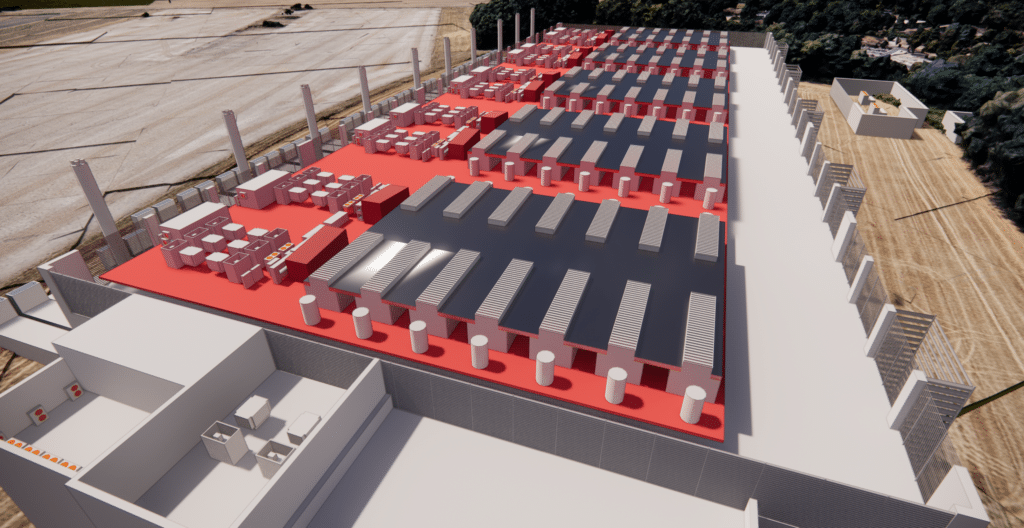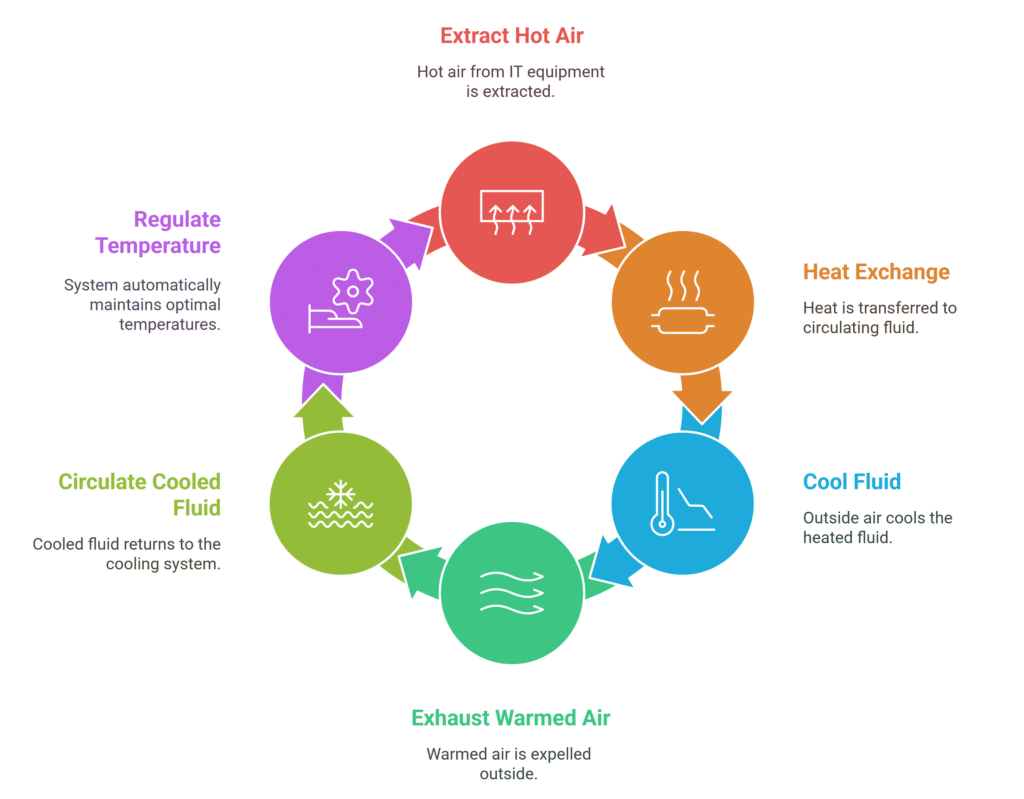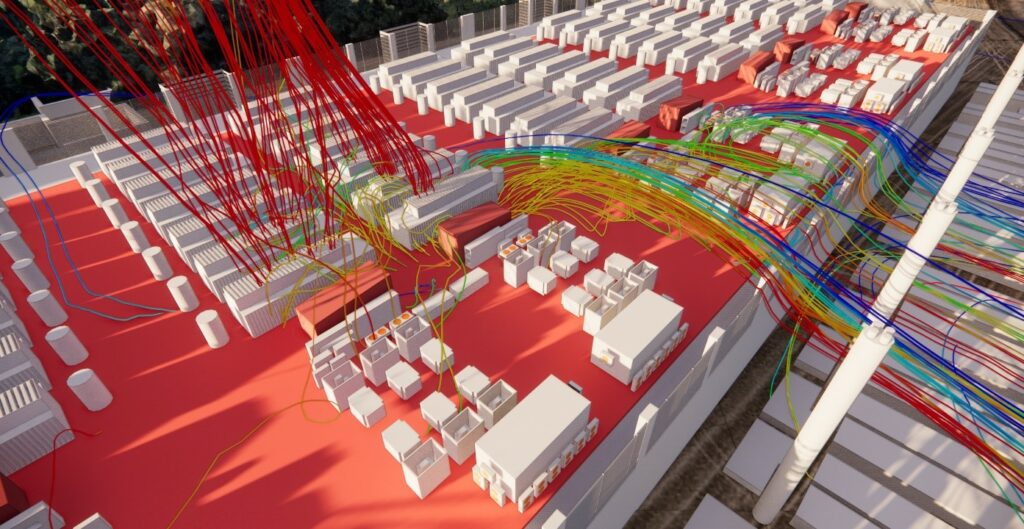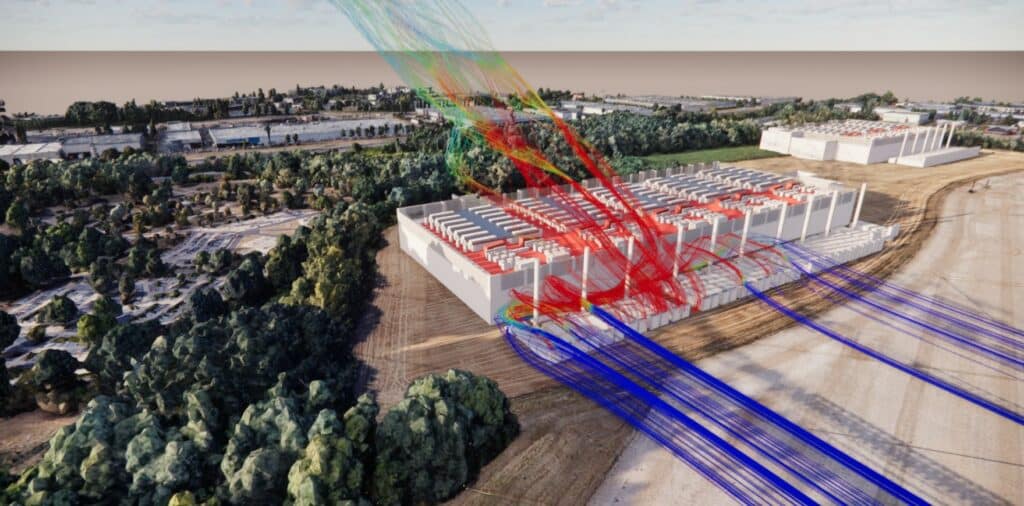External & internal CFD – Data Center Hyperscale
External & internal CFD - Data Center Hyperscale
Year
2025
Customer
NC
Location
France
Typology
Data Center
Home » Data Center » CFD engineering for data centers » External & internal CFD – Data Center Hyperscale
EOLIOS ingénierie's mission: CFD simulation and cooling expertise
Eolios engineers are experts in heat dissipation for data centers
EOLIOS ‘ expertise in CFD (Computational Fluid Dynamics) simulation and cooling system optimization played a crucial role in solving the thermal challenge of a hyperscale data center of several dozen megawatts. Our know-how enabled us to improveenergy efficiency and guarantee optimum performance, ensuring efficient and sustainable thermal management for these complex infrastructures.
EOLIOS is a leader in external CFD simulation for Data Centers. Our studies are based on feedback from measurement campaigns in real-life conditions and from a hundred or so simulated sites around the world.
Hyperscale data centers: a revolution in data hosting and management
The goal of a hyperscale datacenter: optimization and scalability
The impact of thermal plumes outside the building is difficult to predict due to the various variables that design engineers and architects are unable to control. These variables include wind speed, air temperature and humidity, wind direction and other activities surrounding the building. However, these phenomena have an impact on the performance of equipment positioned outdoors.
EOLIOS can help you study the impact of these issues to ensure optimal operation in all circumstances, even the most extreme.
Key properties of hyperscale data centers: modularity, automation and energy efficiency
One of the main advantages of hyperscale data centers is their energy efficiency. They incorporate state-of-the-art cooling systems and energy management technologies that minimize energy consumption while maximizing performance.
This includes the use of free-air cooling systems, geothermal wells or liquid cooling, aimed at reducing thecarbon footprint and optimizing operating costs.
Flexibility andscalability are at the heart of the hyperscale concept. These data centers can be quickly and easily expanded to meet growing demand, thanks to a modular infrastructure made up of standardized components.
This modular framework allows not only simplified maintenance, but also regular upgrades with no major impact on overall operation.
Automation plays a crucial role in the operational efficiency of hyperscale data centers. Automated systems supervise and manage almost every facet of daily operations, reducing the need for constant human intervention and minimizing the risk ofhuman error. This automation includes server management, energy consumption monitoring and preventive maintenance.
In short, thanks to their vast capacity, energy efficiency, flexibility, scalability and intensive use of automation, hyperscale datacenters offer extremely efficient and cost-effective solutions. By reducing unit costs per service, these facilities become essential for companies seeking to support global digital services and meet growing user demands for robust, reliable cloud services.
The challenge of CFD studies - optimizing hyperscale data centers
A CFD (Computational Fluid Dynamics) study is crucial for these hyperscale datacenters to optimize air circulation and cooling, thus minimizing energy consumption while maximizingthermal efficiency.
- Cooling: CFD simulations can be used to model air and heat flows in data centers. This helps optimize server placement, rack layout and ventilation systems to ensure efficient cooling and reduce energy costs.
- Energy consumption: By analyzing air flows and thermal distribution, CFD studies can identify strategies for improvingenergy efficiency. This can include optimizing existing cooling systems or designing new, more sustainable methods.
- Resource management: CFD models help to predict the performance of air-conditioning systems and to better anticipate energy and cooling requirements, thus facilitating efficient resource management.
- Safety: CFD is used to simulate and plan risk management in the event of overheating or system failure, helping to design emergency systems, smoke extraction and fire suppression systems.
By integrating CFD analysis into the design process, hyperscale data centers can improve their operational efficiency, reduce their environmental impact and enhance their security, relying on accurate data and simulations to consolidate climate andenergy-related decisions.
At EOLIOS ingénierie, we have fully grasped the importance of these simulations for designing efficient cooling systems. Thanks to our CFD expertise, we help ensure smooth and efficient operations, reducing costs and contributing to the environmental sustainability of hyperscale datacenters.
In-house study: reducing the risk of overheating by using CFD
CFD, an ally for energy efficiency in data halls
Theoptimization of data halls in data centers is crucial, and the use of numerical simulation (CFD) plays a key role in this. By analyzing air flows, temperature distribution and equipment interaction, CFD helps design more efficient cooling systems. It helps identify hot spots, optimize air circulation and reduce energy costs by fine-tuning air conditioning and rack layout. In this way, the judicious use of CFD not only guarantees better operational performance and increased system reliability, but also helps to reduce thecarbon footprint of data centers, in line with growing environmental demands.
Composition and operation of a data hall: racks, cooling and power distribution systems
A datacenter data hall is an area dedicated to housingcomputer equipment crucial to data processing and storage. It consists mainly of racks, housing servers, storage units and switches for network management.
Racks are often laid out in rows organized into hot and cold aisles, a configuration that optimizes air flow and cooling by separating the hot air expelled from the cool air destined to cool the equipment.
Cooling systems include precision air conditioners or water-cooled chillers, designed to maintain optimum, stable temperatures, despite the heat generated by running servers.
To guarantee a reliable power supply, the data hall is equipped withredundant power distribution systems, often backed up by emergency generators and UPS systems to ensure a continuous power supply in the event of an outage.
Intelligent sensors constantly monitor environmental conditions, such as temperature and humidity, as well as equipment performance, enabling administrators to react quickly to anomalies and ensure optimal operation.
Internal thermal optimization of data centers: challenges and solutions by EOLIOS ingénierie
In this in-depth study, an overheating problem was identified in the left-hand sectiaon of the data hall, crucial to the smooth operation of the entire datacenter. Overheating occurs when two cooling systems fail simultaneously. The racks in this section of the hall can then reach temperatures of 35°C, well above the maximum set point of 28°C. These conditions compromise not only performance but also equipment reliability, increasing the risk of failures that could affect data integrity and service continuity.
The situation is further complicated by the installation of burglar-proof grilles and the room’s spatial configuration, which generate uneven pressure distribution.
A noticeable overpressure zone forms in the hot aisles on the left-hand side of the hall, hindering efficient evacuation of the hot air generated by the servers. This imbalance creates a recirculation phenomenon where hot air is reintroduced into the system, exacerbating the problem through a looping process, and increasing the leakage rate from thehot aisle, thus accelerating the rise in temperature.
The uneven distribution of racks is another contributing factor, since failed cooling systems are expected to handle the high thermal load of the furthest rack island, making this area particularly vulnerable.
To tackle this complex challenge, EOLIOS engineers developed and proposed a series of innovative solutions. Through in-depth discussions and effective communication with the customer, they were able to analyze the proposed options and determine the best approach to mitigating the problem. This solution was implemented in agreement with all stakeholders, guaranteeing an optimal and sustainable response to the issues identified in the data hall.
To tackle this complex challenge, EOLIOS engineers developed and proposed a series of innovative solutions. Through in-depth discussions and effective communication with the customer, they were able to analyze the proposed options and determine the best approach to mitigating the problem. This solution was implemented in agreement with all stakeholders, guaranteeing an optimal and sustainable response to the issues identified in the data hall.

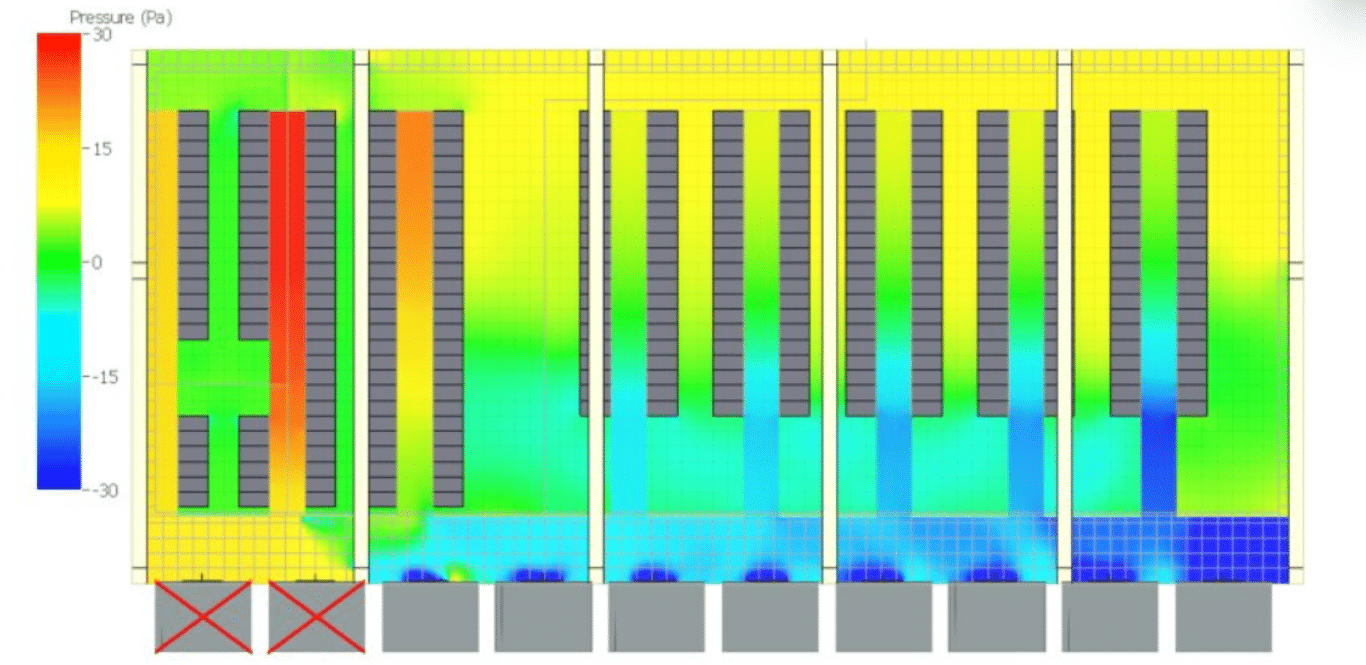
Figure - Temperature and pressure distribution inside a hyperscale data center room
In-house study: reducing the risk of overheating by using CFD
Optimizing cooling systems: improving datacenter efficiency and sustainability
Optimization of cooling systems, such as chillers and generators, is essential to guarantee data center performance. With high densities of servers and electronic equipment, which can exceed 10 kW per rack, thermal management becomes a major challenge. Uncontrolled overheating can lead to hardware failure, reduced reliability and service availability, and premature equipment degradation.
Consequently, optimizing cooling systems does more than just maintain a stable and appropriate temperature; it is also crucial to reducing energy costs, which account for a significant proportion of data center operating expenses. What’s more, by minimizing energy consumption, this optimization helps to reduce thecarbon footprint of facilities, which is in line with the sector’s growing demands for environmental sustainability. The numerical simulations carried out provided detailed information on system temperatures for different scenarios.
Optimizing cooling systems: improving datacenter efficiency and sustainability
Data centers, the nerve centers of modern digital infrastructures, require a range of sophisticated equipment to operate efficiently. Among these, air coolers and generators play a crucial role.
An air-cooled heat exchanger is an essential piece of equipment in data centers, designed to dissipate the heat generated by operating IT equipment. It is an AIR-WATER heat exchanger. It works by usingoutside air to extract heat from cooling systems, thus avoiding excessive heat build-up.
By ensuring a constant flow of fresh air, air coolers contribute to the thermal stability of installations, preserving theintegrity of equipment and reducing the energy costs associated with air conditioning.
Generators are also critical devices in data centers, providing backup power in the event of a failure of the main network. Their role is to provide a reliable, continuous source of power to avoid any interruption in operations, which is vital for service availability and data protection. In the event of a power failure, the generators switch on automatically, taking on the electrical load of the data center’s equipment and cooling systems.
Thanks to these generators, data centers can maintain high availability and resilience in the face of power supply contingencies, guaranteeing the continuity of service essential to modern digital infrastructures.
Composition of critical datacenter systems: air coolers and generators
As part of each study, EOLIOS Ingénierie produces a detailed 3D model, essential for CFD simulations. For this project, the 3D model integrates all systems, as well as elements influencing aeraulics, such as air coolers and generators.
The model is built from the 3D models supplied, site plans and equipment data sheets. The data sheets are used to determine essential characteristics, such as air flow rates and power dissipation, ensuring that each system component is faithfully represented in the simulation. The creation of this digital twin enables precise, detailed analysis of the operating conditions of cooling systems, and facilitates identification of potential points for improvement.
EOLIOS engineers stand out for their in-depth expertise in meshing and convergence, essential elements for the accuracy and reliability of numerical simulations, particularly in complex environments such as data centers. Quality meshing is crucial, as it determines how the simulation space is subdivided into discrete elements, directly impacting the accuracy of results. A fine, well-structured mesh enables airflow variations and temperature gradients to be accurately captured, which is essential for correctly modeling aeraulic phenomena such as looping.
What’s more, a good mesh promotes better convergence of calculations, ensuring that the results obtained are stable and representative of real-life conditions. Thanks to their know-how, EOLIOS engineers optimize the mesh to guarantee robust and reliable simulations, enabling the development of precise and efficient solutions for cooling data centers and other critical environments.
CFD analysis and weather conditions
To simulate realistic operating conditions, an in-depth meteorological analysis was carried out, based on data from the nearest weather station to the site. This analysis enabled us to determine the key variables, such as outside temperature,wind speed anddirection, which have a significant influence on the thermal behavior of the data center. By integrating this data into the CFD simulation, EOLIOS can accurately assess the performance of cooling systems in real-life scenarios, ensuring that the proposed solutions are tailored to the specific site conditions.
The scenarios developed for this project are as follows:
- The influence of different main wind directions.
For the most unfavorable wind direction, two generator extraction models were studied:
- Extraction with discharge at generator level.
- Extraction with a 3-metre chimney to allow higher discharge. The purpose of this duct is to reduce the need for the generators to loop back on themselves.
CFD study results: innovations and sustainable solutions for hyperscale datacenter cooling optimization
Study of prevailing winds: strategy for reducing looping between air coolers
Following meteorological analysis, two prevailing winds were identified. The two prevailing winds were simulated. The results of these studies highlighted various aeraulic phenomena impacting temperatures andair supply to the systems. Looping phenomena between the systems were identified, leading to an increase in air-cooler intake temperatures. Evacuated heat is drawn back in by the same or surrounding systems.
These phenomena were mainly identified on the first air coolers exposed to the wind. Indeed, the wind favors the downwash of thermal plumes, which amplifies the looping phenomena. On the rest of the roof, the phenomenon is smaller and more localized. In this case, it’s mainly due to a lack of air supply, leading to suction of the systems at the top.
The density of rooftop systems is also conducive to these phenomena. Indeed, the power output per m2 is particularly high at this data center, contributing to an overall rise in temperature. In addition, the multiplication of rooftop systems also limits air circulation and favors the appearance of low-velocity zones conducive to calorie stagnation. These stagnation zones have been identified in particular around transformers. Temperatures around these systems are of the order of 50°C.
In order to reduce looping phenomena, a study was carried out involving the addition of a hood over the systems. The addition of an opaque cladding eliminates the suction of the systems in the upper part, which is loaded with calories. Temperatures recorded with this new design were reduced by almost 2°C. As a result, cold power loss has also been reduced, improving theoverall efficiency of cooling systems.
Study of prevailing winds: strategy for reducing looping between air coolers
One of the wind directions on the site is particularly unfavorable for the cooling systems. This wind directs the exhaust from the generators, located close to the building, directly onto the roof where the air-cooled chillers are located. As a result, the heat plumes emitted by the generators are drawn into the chillers, raising intake temperatures and affecting their performance. In addition, this wind direction can also cause the generators to loop back on themselves, generating risks similar to those observed for air-cooled chillers. A specific study has therefore been carried out to analyze the extent of these phenomena.
Despite the low recurrence of this unfavorable wind, it is necessary to take this wind direction into account in view of the risks of a sharp rise in temperature that could result from looping the generators onto the air coolers.
Initial results highlighted the phenomenon of generators looping back on themselves. Although the addition of a 3-meter exhaust duct partially reduced this phenomenon, it is still present due to insufficient fresh air intake from the systems, which increases the intake of hot air at the top.
The discharge from the generators also has a major impact on the suction temperatures of the rooftop air coolers. This is because the plumes from the generators are drawn into the chillers. In addition to this phenomenon, the cooling units have also been shown to loop back on themselves. The combination of these two phenomena results in a significant rise in temperature, with the risk of system failure.
To mitigate these impacts, a study was also carried out, taking into account the unfavorable wind conditions and the addition of a hood over the systems. This solution considerably reduced the average suction temperatures of the chillers by almost 4°C to 5°C. The addition of the hood eliminated the need for looping between the chillers, thus improving their efficiency. However, generator emissions continue to impact the rooftop chillers, although power loss has been reduced thanks to this design.
Analysis of available cooling power for hyperscale data centers
Air coolers are designed to provide the cooling power required by data halls, while maintaining optimum conditions for the operation of IT equipment. This cooling power is guaranteed for operation in “standard” conditions, i.e. for intake temperatures below a predefined threshold. When this temperature threshold is exceeded, the performance of cooling systems decreases and they are no longer able to deliver the full power required, which can affect the reliability andefficiency of overall cooling.
To remedy this problem, EOLIOS carried out a study to quantify the loss of cold power as a function of system intake temperature readings.
These simulations have enabled us to evaluate and compare the various solutions available for optimizing the performance of air coolers under a variety of conditions.
The solution proposed by EOLIOS proved to be particularly effective, reducing power loss by a factor of 5 compared with the initial design. This significant improvement not only guarantees greater thermal stability in the data halls, but also optimizes theenergy efficiency of the installations, reducing operating costs and the risks associated with equipment overheating.
EOLIOS ingénierie's expertise in solving thermo-aerodynamic problems in data centers
Recommendations tailored to each project
Thanks to its expertise in numerical simulation, and more specifically in external simulation of data centers, EOLIOS was able to propose various solutions adapted to the project to mitigate looping phenomena. Easily conceivable and inexpensive solutions were considered, such as relocating the systems or installing shrouds. More costly solutions were also discussed, such as the creation ofoutlets to evacuate plumes to higher ground. After consultation with our customer, certain solutions were selected for a new CFD study. The solutions selected were rigorously simulated. They enabled us to significantly reduce the suction temperatures of the systems, thus improving their efficiency. In view of the results and the cost involved, we decided to redesign the systems and install shrouds on the chillers.
Detailed analysis of available cooling capacity has also enabled the benefits of each solution to be quantified precisely, providing a clear assessment of the impact on cooling system performance.
Thanks to this study, EOLIOS has been able tooptimize the design of rooftop systems. This optimization will reduce the risk of system breakdowns and power loss due to high temperatures. What’s more, the design will reduce the annual energy costs of running the cooling systems. A more detailed study would also enable us to quantify thesavings associated with this optimized design.
Find out more:
Video summary of the study
Summary of the study
The study carried out by EOLIOS ingénierie focuses on thethermal optimization of hyperscale data centers, using CFD (Computational Fluid Dynamics) simulations. This approach improves air circulation andcooling system efficiency, thereby reducing energy consumption andcarbon footprint. Hyperscale datacenters, used by technology giants such as Amazon and Google, require modular, automated and sustainable solutions. EOLIOS has identified problems such as overheating and looping, and proposed solutions such as the installation of hoods to mitigate these phenomena. The integration of digital twins for accurate simulations has enabled significant improvements to be envisaged. Working closely with customers, EOLIOS has optimized the configuration of cooling systems, increasing efficiency while reducing energy costs. This study demonstrates the crucial impact of CFD simulations on the performance and sustainability of modern datacenters.
Video summary of the mission
Discover other data center projects
Engineering smoke extraction in a data center
External & internal CFD – Data Center Hyperscale
CFD Optimization – Data Center
Data Center – DC28 – Internal
Pressure loss study – Generator – Data center
Data Center – PA 22 – External
Technical premises – Data Center
Cooling optimization – Data Center
Data Centers – DC15.1 & DC15.2 – External
Data Center – Paris
Data Center – GAZ NOVEC
Data center – DC25 – Internal
Data center – DC17 – Internal
Data Center – DC10 – Internal
Data center – DC25 & DC26 – External
Data center – D14 – External
Data center – DC17 – External
DC23 – External



